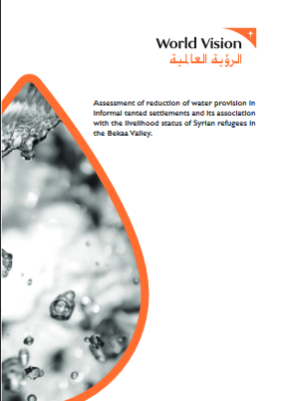Assessing the reduction of water provision in ITSs and its association with the livelihood status of Syrian refugees in the Bekaa
 |
rapport Sep 2018 ; 32 pages
Ed. WVI - Mansourieh WVI - Milton Keynes
Téléchargeable sous format: PdF
Téléchargeable chez l'éditeur
Abstract:
This study examined the problem of providing less water quantities to Syrian refugees following the funding cuts in the first half of 2018 in the water, sanitation and hygiene (WASH) sector and its association with their livelihood status in terms of employment, expenditures and livelihood coping strategies. To assist them previously in water provision, Syrian refugees in informal tented settlements (ITS) in the Bekaa were supplied with an average of 35 litres per capita per day (l/cap/day). However, this amount decreased gradually from January 2018 following donor funding cuts, and reached half this amount as of March 2018 (approximately 15 l/cap/day). The objective of this study was to assess the association of this water reduction with the employment status of household (HH) members, child labour (CL), HH monthly expenditures, as well as with livelihood coping strategies. Contents:
I. Overview of the syrian refugee crisis with regards to WASH assistance and to water reduction in literature
A. Syrian refugees’ poverty status, livelihood conditions and WASH assistance
B. Reduction of provision of water to Syrian refugees
C. Reduction of water provision and its association with the livelihood status of Syrian refugees
1. Syrian refugees’ livelihood coping strategies
2. Water reduction and its association with WASH expenditures
3. Water reduction and its association with health-care expenditures
4. Water reduction and its association with other essentials expenditures
5. Water reduction and its association with employment status
6. Water reduction and its association with debt status
II. Methodology
A. Research objectives
B. Study design
C. Target population
D. Sampling technique
E. Sample size
F. Tool
G. Data collection
H. Statistical analysis
I. Ethical considerations
III. Limitations
IV. Results And Analysis
A. Demographic and socio-economic characteristics of household members
B. Impact of reduction of water provision on households’ employment status
C. Impact of reduction of water provision on households’ expenditures
D. Livelihood coping strategies
Public-Cible:
Mot clef: |
Pays concerné: |
Editeurs/Diffuseurs: |
|
WVI
-
World Vision - Mansourieh - Liban |
WVI
-
World Vision UK - Milton Keynes - Royaume Uni |
En cas de lien brisé, nous le mentionner à communication@pseau.org